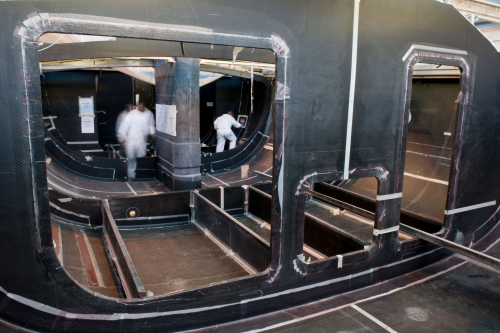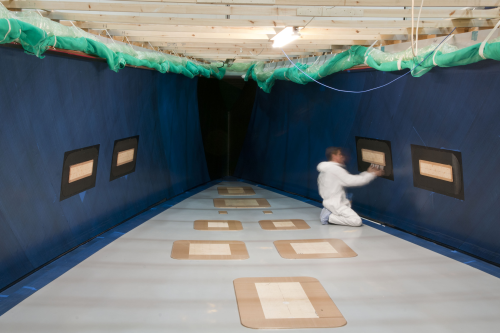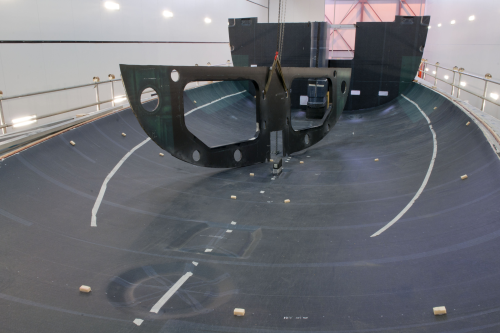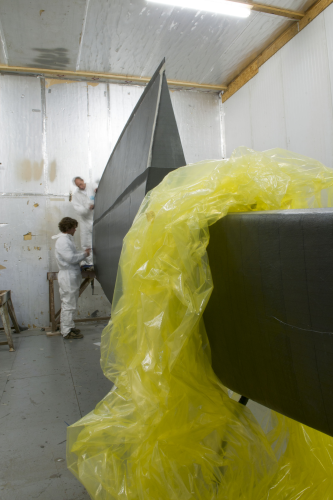




Two vessels currently taking shape at a marine park in Hythe, Southampton, UK, will be among the world’s largest and most prestigious performance yachts when launched next year. Each with a length of 30 m plus, these craft will demonstrate what can nowadays be achieved in marine composites (particularly carbon fibre composite sandwich construction) and by a close working partnership between materials supplier and marine fabricator.
The collaboration we refer to is that between SP-High Modulus, the marine business of composite materials group Gurit, and Green Marine, leading UK builder of large, high-performance carbon yachts, both sail and power.
“It began some 30 years ago when SP Systems on the Isle of Wight started to supply materials that could improve the boatbuilding state of the art," relates Geoff Stock, Green Marine’s Technical Director.
"Both Paul Rudling, instigator of SP Systems, and Bill Green, who with Ian King had set up Green Marine in Lymington [a UK south coast town noted for sailing activities] to build fast yachts, could see that new materials would be key to transforming performance on the water. That common interest made our fledgling companies natural partners and we have been evolving in close contact ever since.”
Both had noted the potential offered by epoxy resin, new to the marine scene at the time, and Green Marine used SP 110, a new epoxy laminating resin developed by SP Systems, in building the yacht Panda in 1982. Green Marine also utilised carbon in this structure, placing itself well ahead of the curve in the carbon/epoxy revolution that was to overtake performance craft construction. SP Systems, too, was an early proponent of carbon and rapidly included it in the growing palette of composite materials it could offer to boat builders.
Both companies saw that the new composites, with superior non-isotropic properties provided by high-performance aligned fibres, enabled a more highly engineered approach to be taken to marine structures. For racers built to the International Offshore Rule, Green Marine employed advanced engineering fabrics that included carbon and aramid (Kevlar), along with sandwich structures utilising polyvinyl chloride (PVC) foam cores. The higher and more consistent laminate quality facilitated by these materials enabled the fabricator to series-produce hull and deck structures for high-specification craft such as RNLI lifeboats, while continuing with its founding discipline of fabricating fast bespoke yachts.
In the early 1990s Green Marine began to produce large maxi yachts, an early example being the 26 m Whitbread racer British Defender which had a low-weight sandwich primary structure utilising unidirectional carbon, Kevlar and PVC foam core. By then the boatbuilder was also calling on SP Systems for structural expertise, the Isle of Wight company having developed the ability to provide engineering solutions allied to its materials.
From go-karting to Formula 1
Thanks to continued composites evolution, the boat building environment today is hardly recognisable as the activity that was in its infancy three decades ago.
“In the old days of wet lay-up, you’d quickly mix your resin and hardener, hoping you’d got the proportions right according to the manufacturers’ given ratios, and then it would be a race against time to wet out the chopped strand mat and lay-up the material in the three or four hours working time you’d have left before the resin went off," Geoff Stock recalls. "It was messy work and there was plenty of trial and error. Getting consistent laminate quality was a challenge."
“All that has changed. Using dry materials like prepregs and SP-High Modulus’ resin film infusion technology (SPRINT), is much cleaner while giving improved control over resin to fibre ratios and fibre orientation. Quality and consistency are built into the materials.”
Fibres, too, have kept pace – particularly carbon. Glass is still used, though not on a large scale and Kevlar is sometimes specified for its abrasion resistance, albeit not as widely in primary structure as was once the case. In general, carbon is the majority material in the craft Green Marine builds now.
Phil Aikenhead, Regional Sales Manager at SP-High Modulus, agrees that carbon has become the top choice for high performance yachts.
| A popular form of low-weight construction is carbon/epoxy skins over a structural foam core. |
| Phil Aikenhead, Regional Sales Manager, SP-High Modulus |
“Carbon has excellent properties and has become much more affordable," he declares. "In fact, today it costs less than it did 20 years ago. We offer boat builders a selection of modulus and strain combinations in unidirectional or multiaxial fabrics. A popular form of low-weight construction is carbon/epoxy skins over a structural foam core. For resilience against high slamming loads in forward hull sections, our Corecell™ styrene acrylonitrile (SAN) foam is proving a winner. Corecell offers a solution to the outgassing issues experienced with other foam cores when used in high-temperature prepreg curing applications.”
A tour of the working area at Hythe is a powerful reminder of how materials evolution has transformed working conditions for boat builders. Gone are the liquid resins, the smell of styrene and the wet lay-up methods that were once the norm. Today’s laminators work in clean, well ventilated conditions using dry materials.
“There’s a much greater emphasis on health and safety these days, and some of the practices one used to see would not be allowed now," says Phil Aikenhead.
"Another big issue is quality and the traceability associated with that. For example, let’s say there’s a failure at sea somewhere and, as a result, suspicion falls on the third layer in a five-ply outer skin at a given point in the structure. Fabricators like Green Marine can look at their records and trace that ply back to a particular shift on a particular day, and we at SP-High Modulus can take it further, tracing back to specific production batches and even to the machine operator on shift at the time. You can then decide whether the issue is one of material manufacture, or the actions of the laminator or machine operator on that day. Either way, you can isolate and fix the problem.”
Evolution in materials has gone hand in hand with that in boats themselves, as Geoff Stock explains.
“Owners generally want boats that are bigger and faster than the previous generation. This means higher loads and stresses; everything ramps up. Structures are carefully engineered to accommodate this, but to much tighter limits than used to be the case so that weight is minimised. It’s a complete contrast to the early days – we’ve gone from go-karting to Formula 1!”
In build
In build currently at Hythe are Inoui, a 110 ft, 85 tonne high-performance cruiser designed by Philippe Briand and a 100 ft, 45 tonne racer designed by Judel Vrolijk, with engineering of the composite structures performed by StrucTeam Ltd, Isle of Wight, UK. Additionally, work is taking place on a 68 ft fast cruiser from Reichel Pugh’s design office. All are one-off carbon composite sailing yachts.
Green Marine will itself complete the 100 ft yacht for a British owner, but the primary hull and deck structure of Inoui, when finished, will be transferred to Vitters Shipyard in the Netherlands for fitting out and completion.
Green Marine recently became part of the Vitters group, the Dutch concern having acquired the British company in 2009, recognising the fact that carbon composite will increasingly be used for the primary structure of large superyachts. Interestingly, this change mirrored the earlier acquisition of the material supplier SP Systems (subsequently SP-High Modulus) by the Swiss materials and engineering organisation Gurit.
Work on all three vessels is taking place in controlled environmental conditions in a 60 000 ft2 factory to which Green Marine moved its yacht building activities in early 2011, having previously been at factories in Southampton and in Lymington. The move to these riverside premises has enabled Green Marine to plan for even larger yachts than those in progress at present. Existing factory bays can accommodate vessels up to about 150 ft, while construction of still bigger craft is allowed for by the use of modular building bay extensions.
Both current vessels seen by Reinforced Plastics in build are being moulded in large wooden female moulds constructed by the company itself. Stock explains that enormous moulds for hulls and decks, built using CNC-cut Sterling board (MDF) overlain with battens, plywood and finally a faired fibreglass surface, are highly stable and can be dimensioned to within 1.5 mm tolerance. Not all vessels are female moulded and on occasion there is even mixed provenance as with, for instance, the 115 ft luxury sailboat Sojana the company moulded a few years ago which had a male moulded hull and female moulded deck.
Craft may be moulded upright or upside down. Lay-ups are either monolithic, chiefly for hull bottoms, or sandwich. Typically, SP-High Modulus carbon prepregs are used, these being unidirectional plus some multi-axial fabrics, pre-impregnated with a resin such as SE84 or SE70. Core material may be Nomex honeycomb for the majority of the hull and deck, along with Corecell SAN for extra resilience in areas that will be subject to high slamming loads at sea.
Cure takes place in large ovens, the modular concept of which was devised in house. Oven sections of impressive proportions, 9 m by 11 m by 8 m, comprise steel frames, bolt-on side insulation panels and a beam-supported top. Each has built-in ducting for air circulation and thermal sensor cabling. Thermal conditions are closely controlled and monitored by a data logging system. In each oven, a ‘ring main’ suction pipe provides vacuum once a laminate has been bagged up.
Currently the production area at Hythe is configured as two major bays incorporating 38 m twin ovens, and a central ‘freestyle’ manufacturing area. At the time of our visit, one of the oven bays was occupied by the bottom of the 110 ft craft, being moulded upright. This is of sandwich construction made from prepreg skins over high-density structural foam core.
Referring to the visible inner skin, Geoff Stock explained that it comprises unidirectional prepreg interleaved with SPRINT. This combination utilises the dry fibre air path of the SPRINT to remove air under vacuum from the laminate plies, while also requiring less debulking than prepreg alone. SP-High Modulus has supplied its SE84 carbon prepreg incorporating T700 high-strain carbon, and SPRINT ST94. The sandwich core is of Corecell foam, in thicknesses ranging from 36 mm generally to 50 mm at the bow. Nomex core is used in the deck structure. Corecell sections are pre-cut and thermoformed at 85°C to fit precisely into their allotted spaces.
Discussing the cure process, Stock explained that an entire hull can be cured in just two or three cook cycles. This would involve vacuum bagging and curing the outer skin, core and inner skin separately or, in a two-stage process, the outer skin and core together followed by the inner skin. Cure takes place at 85°C or slightly more, typically for 12 hours – although, allowing for dwell periods the complete process can take a couple of days for a yacht this size. The emphasis in bespoke yacht building at this level is to achieve the best possible cure, cycle time being less of an issue than it would be for a volume production boat builder.
Second bay
The 100 ft craft in the second construction/oven bay was, when seen, in a more advanced state of build, with the hull and primary structure substantially in place. Hull sides are of sandwich construction with carbon/epoxy skins bonded to the core. The skins comprise about 14 layers altogether, eight in the 2.5 mm thick outer skin and six in the 2 mm inner. The core is mainly Nomex honeycomb, with Corecell being used in slamming areas where its 50% greater elongation provides high resilience. Interestingly, the hull of the 110 ft craft is being moulded in two parts – the bottom up to the waterline and the topsides. Such is the moulding precision that can be achieved in the female moulds that the two finished parts will fit precisely when brought together so that a firm bond can be formed using SP-High Modulus’ Spabond 540 along with reinforcing laminations. The topsides section is moulded upside down, this method often being preferred for large hull fabrication because it allows faster progress, for example providing easy access for the laminators without the use of scaffolding. Complex moulding in the gunwhale area where the hull and deck will join is facilitated by working at base level.
Bulkheads and other planar components are, in the main, carbon/sandwich structures fabricated on large vacuum tables where blemish-free flat moulding surfaces are maintained.
A team based at the Hamble office of SP-High Modulus is responsible for the 110 ft vessel’s structural design, although Green Marine has now built up a level of engineering strength of its own at Hythe. Its new office has sophisticated capability including workstations on which 3D modelling, driven by SolidWorks® software, can be carried out. This should help ensure that systems and components originating from outside suppliers as well as in house, should all interface properly when brought together at the vessel fit-out stage.
Components
Composite components are another activity that has gained from close collaboration between the two companies. Over the years, Green Marine has developed a speciality in producing rudders and other appendages for high-performance yachts. Carbon composite materials enable designers to specify the ever higher aspect ratios (length to chord) required for top hydrodynamic efficiency, since carbon is lighter than its metal competitors and equally stiff.
Last year the components team constructed a 7.5 m long rudder, one of the largest composite rudders, for a 66 m superyacht in build at Vitters Shipyard. As well as providing the base material, SP-High Modulus worked with its client and Lloyds’ Certification office in creating a test programme to validate the properties of the chosen materials.
The rudder, designed by Dubois Naval Architects, was laminated using approximately 1 ton of carbon prepreg. In service the rudder will be subject to enormous twisting and bending loads, and the Dubois office has calculated that the reaction load at the lower bearing will be up to 160 tonnes. The rudder also features a crash tip that will snap off in the event of the vessel grounding.
|
Building the rudder from carbonfibre prepreg gives us the best combination of strength and stiffness at the lowest possible weight. |
| Marcus Attridge, Green Marine project manager |
Marcus Attridge, Green Marine’s project manager explains why carbon is the best building material for such projects.
“Building the rudder from carbonfibre prepreg gives us the best combination of strength and stiffness at the lowest possible weight. The rudder is one of the most critical components on any yacht, and accuracy and structural integrity must be 100% for a rudder of a vessel this size.”
Cure in the company’s 4.95 m x 1.85 m autoclave, which is capable of 8 bar pressure and up to 180°C, highlights the extreme quality aimed for. Cure parameters for rudders, canards, keel boxes and other components are computer controlled and logged. 3D precision measurement equipment is used to validate the accuracy of foil shape and bearing alignment.
Canards used on ocean racing yachts place equally high demands on tooling and manufacturing techniques. For these, Green Marine similarly utilises CNC machined female mould tools, autoclave curing and high-specification materials more usually associated with aerospace and Formula 1 motor racing. Green Marine has succeeded in making its name synonymous with high performance, carbon composite marine vessels of top quality. Famous winners including Ghost, Cindarella IV, Sojana, the TP52s Container and Ran IV, plus several Open 60s and Volvo 70s, attest to the success of its methods. Immediately before constructing the vessels outlined earlier in this article, the company produced the carbon hull, deck/superstructure and rudder for Sarissa, a 138 ft long carbon composite superyacht completed at Vitters Shipyard in the summer of 2011.
Whilst this UK company goes from strength to strength by maintaining its ambition and focus, SP-High Modulus, likewise, continues to thrive at the leading edge. It seems that this prime example of a productive working relationship operates in a symbiotic way, success for one reinforcing that of the other. Both companies are highly respected in their fields and believe they are well placed to survive the present economic maelstrom. Strongly in their favour is the fact that they still share the passion that first brought them together – the quest for ever greater performance on the water. ♦
This article was published in the January/February 2012 issue of Reinforced Plastics magazine. To apply to receive your free copy of each issue of Reinforced Plastics please complete the subscription form.
